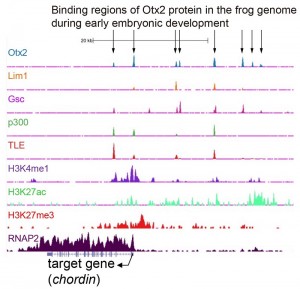Molecular mechanism of head formation conserved from fly to human Lessons from the study of the organizer genes in frogs

Otx is a gene regulatory protein, a type of protein that acts as a switch turning gene expression on or off. Otx is known to be involved in head formation during early embryogenesis of animals that possess a head (called bilaterians), such as flies and humans. However, it was unclear why and how the same protein Otx was involved in head formation in both species, because flies and humans have completely different head morphologies.

© 2014 Yuuri Yasuoka and Masanori Taira.
An example of the result of ChIP-sequence analysis. Binding of various proteins to the genome DNA of Xenopus tropicalis embryos is presented as a peak. Through binding to DNA, these proteins are suggested to regulate chordin, which is an important gene during early development. This study has shown that Otx2 and Lim1 bind to the upstream region of the chordin gene to turn it on in the organizer.
Dr. Yuuri Yasuoka, who was a graduate student in the research group led by Associate Professor Masanori Taira in the Department of Biological Sciences, the Graduate School of Science, the University of Tokyo (currently a JSPS research fellow in the Okinawa Institute of Science and Technology), analyzed molecular mechanisms of head formation in Xenopus (clawed frog) embryos by utilizing the latest next-generation sequencing technology in collaboration with two other laboratories. The results revealed that the Xenopus Otx protein binds to cis-regulatory regions, which function as switch boxes for gene expression, and turns on target genes in concert with the gene-regulatory protein Lim1, whereas it turns off other target genes in concert with the gene-regulatory protein Gsc. That is, Otx acts as a molecular landmark of the head region in the body, whereas Otx-partner proteins, such as Lim1 and Gsc, determine what structures of the head are formed through cis-regulatory regions on the genome DNA.
The regulatory principle discovered in this study sheds light on the evolutionary process of diverse head structures seen in flies to humans since they diverged around 700 million years ago, even though they use the same protein Otx to turn on or off the genes necessary for or inhibitory to head formation.
This study was carried out in collaboration with the research group led by Professor Sumio Sugano in the Department of Medical Genome Sciences, the Graduate School of Frontier Sciences, the University of Tokyo, and the research group led by Dr. Makoto Asashima in the Research Center for Stem Cell Engineering (SCRC), the National Institute of Advanced Industrial Science and Technology (AIST).
Press release (Japanese)
Paper
Yuuri Yasuoka, Yutaka Suzuki, Shuji Takahashi, Haruka Someya, Norihiro Sudou, Yoshikazu Haramoto, Ken W. Cho, Makoto Asashima, Sumio Sugano & Masanori Taira,
“Occupancy of tissue-specific cis-regulatory modules by Otx2 and TLE/Groucho for embryonic head specification” ,
Nature Communications 5, Article number: 4322, Online Edition: 2014/7/9 (Japan time), doi: 10.1038/ncomms5322.
Article link
Links
Department of Biological Sciences, Graduate School of Science
Laboratory of Molecular Biology, Department of Biological Sciences, Graduate School of Science (Japanese)







